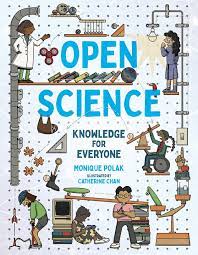Open Science: Knowledge for Everyone

Open Science: Knowledge for Everyone
Citizen science is the term for public participation and collaboration in scientific research. Most citizen scientists are volunteers, meaning they are not paid for their work. And don’t forget, kids are citizens too? (p. 48)
Open Science: Knowledge for Everyone belongs at the top of your Must-Have list for many reasons but let me start with “Stall Catchers”.
“Stall Catchers” is a video game in which players catch “stalls”—which are actually clogged blood vessels—in movies of mouse brains. That’s because scientists at Cornell University believe they have discovered links between clogged blood vessels and Alzheimer’s. By reducing the number of clogged blood vessels in mice, scientists were able to restore memory in mice. But the scientists realized they would need to study a lot of data—which would take years. So they turned to citizen scientists and SciStarter for help. Players score blood vessels as moving or stalled. By doing so, they may be helping to speed up Alzheimer’s research. (Pp. 49-50)
Author Monique Polak and illustrator Catherine Chan have combined clear text with colourful illustrations of people of all ages, abilities, and colours actively engaged in STEM activities. Black and white, and colour photographs add additional information, and infographics, such as “PHASES OF VACCINE DEVELOPMENT”, (p. 70) illustrate complex procedures.
The theme of Open Science: Knowledge for Everyone is that knowledge is meant to be shared by everyone and with everyone. Whether you are a research scientist or a elementary school-age student, everyone can contribute, and all knowledge should be combined to accelerate innovation and discovery.
Open Science: Knowledge for Everyone is organized into six chapters, beginning with a history of scientific research and how this research has traditionally been funded and shared from Imhotep in the 27th century BCE to the COVID pandemic.
Other chapters are “Big Science is Big Business”, “Big Data”, “We Can All Do Open Science”, “Making Room for Everyone”, and “Open Science in Action”.
“Making Room for Everyone” examines topics such as “White Male Privilege”, “Equity, Diversity and Inclusivity in Science”, and “Racism in the World of Science”. Written at a middle school level, this book tackles tough topics with respect and with thought-provoking questions.
Here’s another question for you. Shouldn’t a young Black female from sub-Saharan Africa who dreams of becoming a scientist have the same opportunity as a young white man from a wealthy North American family? The truth is, it will be much harder for the young Black woman from sub-Saharan Africa to realize her dream. (p. 54)
“A Final Word” reinforces the importance of sharing.
If scientists and medical researchers openly share data and reagents, if that sharing is available to everyone—regardless of where individuals live or the color of their skin or their religion or whether they are disabled or whom they love—we can work together to more quickly find treatments for diseases and make the world a safer and better place for all of us. (p. 77)
Let’s imagine a perfect world where librarians exist in every school, and each of those librarians introduces this book to half a dozen classes. In those classes, two or three students are empowered to become citizen scientists. And those young students go on to introduce their friends, colleagues, partners and future children to the concept of open science. The potential is immense. It is easy to see that the investment in Open Science: Knowledge for Everyone could lead to a break-through in some as yet unidentified area. Put it at the top of your Must- Have list.
Suzanne Pierson tends her Little Free Library in Prince Edward County, Ontario, for the enjoyment of her friends and neighbours of all ages.
